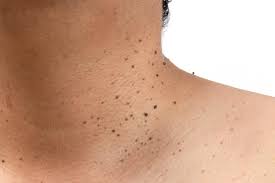

What Is Skin Tags And How To Remove?
Skin tags, medically known as acrochordons, are small, soft, benign growths that commonly occur on the skin’s surface. While they are generally harmless, they can sometimes be a source of discomfort or cosmetic concern for individuals. In this article, we’ll delve into what skin tags are, explore their causes and symptoms, and discuss available treatment options.
What Are Skin Tags?

Skin tags are small, flesh-colored or slightly darker growths that typically appear in areas where the skin folds or rubs together. They are composed of loose collagen fibers and blood vessels covered by a thin layer of skin. Skin tags can vary in size, ranging from a few millimeters to several centimeters in diameter, and they often have a stalk-like structure that attaches them to the skin’s surface.
Skin tags can appear on various parts of the body, but they are most commonly found in areas where the skin rubs against itself or clothing. Some common locations where skin tags may appear include:
- Neck: Skin tags are frequently found on the neck, particularly in areas where collars or necklaces may irritate the skin.
- Underarms: The friction caused by clothing and movement in the underarm area can lead to the development of skin tags.
- Groin: Skin tags may occur in the groin area due to friction from clothing or skin folds.
- Eyelids: Skin tags can develop on the eyelids, although this is less common than in other areas of the body.
- Under the breasts: Skin tags may form in the creases beneath the breasts, where moisture and friction are common.
- Around the genital area: Skin tags can appear in the genital area, particularly in women, where they may be aggravated by underwear or shaving.
Overall, skin tags can occur anywhere on the body, but they are most frequently found in areas where the skin folds or rubs together.
Causes of Skin Tags
The exact cause of skin tags is not fully understood, but several factors may contribute to their development. These include:
- Friction or Rubbing: Skin tags often form in areas where the skin experiences friction or rubbing, such as the neck, armpits, groin, or beneath the breasts.
- Hormonal Changes: Fluctuations in hormone levels, such as those that occur during pregnancy or in individuals with hormonal imbalances, may increase the likelihood of developing skin tags.
- Genetics: There may be a genetic predisposition to developing skin tags, as they tend to run in families.
- Obesity: Being overweight or obese is associated with an increased risk of developing skin tags, possibly due to excess skin folds and increased friction.
Symptoms of Skin Tags
Skin tags are typically painless and asymptomatic, but they may cause discomfort or irritation if they rub against clothing or jewelry. Common symptoms of skin tags include:
- Soft, flesh-colored or slightly darker growths on the skin
- Small, round or oval-shaped bumps
- Stalk-like structure attaching the skin tag to the skin’s surface
- Presence in areas where the skin folds or rubs together
Treatment Options for Skin Tags
While skin tags are harmless and often do not require treatment, some individuals may choose to have them removed for cosmetic reasons or if they cause discomfort. Several treatment options are available for removing skin tags, including:
- Cryotherapy: This involves freezing the skin tag with liquid nitrogen, causing it to fall off over time.
- Electrosurgery: A medical professional uses a high-frequency electrical current to cut off the skin tag.
- Ligation: This involves tying off the base of the skin tag with a sterile thread or string to cut off its blood supply, causing it to eventually fall off.
- Excision: A doctor may use a scalpel or surgical scissors to cut off the skin tag under local anesthesia.
- Over-the-counter Remedies: Some over-the-counter products, such as skin tag removal creams or solutions containing salicylic acid or tea tree oil, may help dissolve skin tags over time.
It’s important to consult with a dermatologist or healthcare provider before attempting to remove skin tags at home, as improper removal techniques may lead to infection or scarring.
In conclusion, skin tags are common benign growths that can appear on the skin’s surface due to factors such as friction, hormonal changes, genetics, or obesity. While they are generally harmless, individuals may choose to have them removed for cosmetic reasons or if they cause discomfort. Various treatment options are available for removing skin tags, ranging from cryotherapy and electrosurgery to ligation and excision. If you have concerns about skin tags or are considering removal, consult with our qualified nurse for personalized advice and treatment options.
Safely and effectively remove your skin tags in a single day.” Book Now
